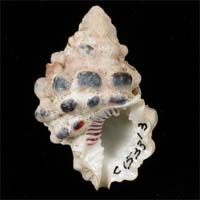|
< Previous family introduction |
|
|||||
 |
Family
Bursidae
Frog Shells |
|||||
|
Shells of the family Bursidae are commonly called Frog Shells because of their warty, pustulose surface. They resemble the tritons in shape and size, but differ by having an anal canal at the posterior end of the aperture in addition to the normal siphonal canal at the anterior end. Varices are present as in the tritons, in most species lining up along the sides of the shell. Most bursid species occur in tropical shallow water on coral reefs or rocky shores, but there are a few which occur in deeper water on the continental shelf in a variety of sand and mud habitats. Food appears to be tube-bearing polychaete worms; bursid animals are equipped with an extendible proboscis and large salivary glands, which are probably use to anaesthetize the worms in their tube; the worms are then sucked out and swallowed whole. With the exception of one species, the bursids found in NSW are at the extreme southern end of Indo-West Pacific tropical distributions. They occur uncommonly in northern NSW, only rarely being found as far south as Sydney. The exceptional species, Bursa verrucosa, has an unusual restricted distribution in the south-western Pacific. Family References
Identification Notes Varices are present in bursid shells as in the ranellids, usually occurring every half whorl and lining up along the sides of the shell. There is a well defined posterior canal not found in the Ranellids, and the periostracum is absent or thin. Coverage In additional to the illustrated species, the following tropical species intrude into NSW. (Deshayes, 1832). Indo-West Pacific to Tweed Heads, NSW. Also known from a single specimen dredged from Sydney Harbour, probably sub-fossil, which was described as Gyrineum pacator Iredale, 1931. Bursa rhodostoma (Sowerby, 1836). Central Indo-West Pacific to Sydney, NSW. Known in NSW from only one live and one dead shell from Sydney Harbour. Bursa rosa (Perry, 1811). Indo-West Pacific to Woolgoolga, NSW. Tutufa oyamai Habe, 1973. Central Indo-West Pacific to Woolgoolga, NSW. |